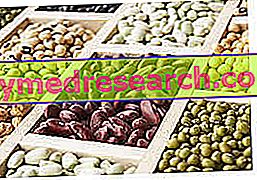Generality
Beans, intended as foods, are the seeds produced by some annual herbaceous plants, belonging to the Fabaceae family (Leguminosae). The binomial nomenclature of the bean plant is Phaseolus vulgaris ; to tell the truth, however, with the term beans you could indicate many more Species, belonging also to different Genres and Sub Genres; let's see why.

On the other hand, the Old Continent, like Africa and Asia, already had its own edible legumes, even before they were imported from the Americas; for example, it is a native of the Old World a good part of the Genus Vigna, also belonging to the Fabaceae family. Some known Species of the Vine are: angularis (aduki bean), mungo (black indian bean), radiata (green indian bean), ungulculata (cowpea) etc. Ultimately, the term "beans" is a wholly generic noun, attributable to the seeds of leguminous plants that roughly resemble each other due to their physical and (hypothetically) taste characteristics.
NB . some varieties of beans boast an edible portion that is not limited to the seed, but also extends to the pod (similar to the Taccole for peas).
From a nutritional point of view, beans are legumes and as such belong to the fourth food group. These are particularly nutritious foods, which are consumed due to their starch content, fiber, mineral salts and B group vitamins. In addition, beans contain numerous phytotherapeutic molecules that are very useful for metabolic balance (eg lecithins, phytosterols and antioxidants).
Bean Flour
Bean flour is a powder obtained from the pulverization of dry and raw seeds; in Italy it is available at retail especially that obtained from the seeds of Phaseolus vulgaris (Borlotto variety), but there are also different products, basically exotic, such as the well-known "Egyptian bean" flour ( Dolichos lablabb ).
Bean flour is obtained mainly through " cryomacination ". This system involves the use of liquid nitrogen for breaking seeds in " pegs " mills; these, very similar to stone mills, instead of having millstones, are equipped with steel discs that rotate quickly. Cryomacination is necessary to prevent the typical consistency of the beans (soft and tenacious) from interfering negatively in more traditional systems (stone cylinders).
Raw bean flour is a food rich in anti-nutritional elements of the " antitrypsin " type. This glycoprotein - despite being an essential component for the human body (it is produced by the liver and immune cells and is therefore present in many tissues) - if it is fed into the intestine with food, it is responsible for the inhibition of many proteases ( lytic enzymes) that will no longer be able to perform their digestive function on peptides. To destroy its anti-cryptic effectiveness, most companies distribute already cooked bean flour (about 90 ° C for 180 '); on the market, however, it is also possible to find the raw one, which however must necessarily be treated with heat at home.
Bean meal is widely used in naturist dietary regimes. IT IS GLUTEN FREE, an aspect that makes it extremely suitable for the nutrition of celiac (gluten-free). Being rich in proteins, it is also used by vegans with the aim of increasing the amount of total amino acids and the Biological Value of cereal-based foods. In bread making, the raw one is used in a ratio of 1 to 4 with that of wheat (prevalent), to the advantage of the taste of the dough, but at the expense of the overall strength. Baked bean flour, on the other hand, can be used to prepare velvety, soups and post-weaning baby jams in alternation with baby foods (as advised by the pediatrician). Other curious applications of bean flour are: bean piadina (instead of or with a smaller part of wheat flour) and bean farinata (instead of chickpea flour).
From the nutritional point of view, the bean flour brings a considerable amount of energy, however lower than that of the actual cereals. Calories are mainly supplied by complex carbohydrates (starch), to a lesser extent by proteins (of Medium Biological Value) and only marginally by lipids (mainly unsaturated). The fiber intake is excellent and makes it a product suitable for feeding the subject suffering from constipation.
As for the vitamins, CRUDA bean flour is rich in B vitamins (thiamine and niacin), while the cooked one suffers at least a partial loss. With regard to mineral salts, bean flour is known for its content of potassium, phosphorus, calcium, magnesium, iron, zinc and selenium, essential and very important elements. Also for these characteristics (above all for iron and calcium, as well as for proteins), bean flour is extremely useful in the vegan diet. There are also useful molecules such as phytosterols, lecithins and antioxidants.
The nutritional complex of bean flour makes it a very interesting product. It has a moderate glycemic index, an essential characteristic of the diabetic, hypertriglyceridemic and obese diet. Thanks to the presence of phytotherapeutic molecules such as viscous fibers, phytosterols, lecithins and antioxidants, bean flour is extremely useful also in the diet of hypercholesterolemic. Moreover, as anticipated, due to the considerable fiber content (which promotes intestinal peristalsis and feed the bacterial flora), bean flour also lends itself very well to the treatment of constipation and / or as a preventive food for bowel cancer.
In addition to antitrypsin, bean flour also contains a fair amount of phytates. If the former is able to hinder protein digestion but is degraded by heat, the latter tend to chelate certain mineral salts worsening intestinal absorption. Phytates are usually eliminated from dried beans by soaking and discarding the remaining water; on the other hand, this passage does not take place in bean flour, which is why it is conceivable that the relative content is much higher.
The average portion of bean flour is about 70-100g, to be consumed only once a day if alternating with wheat or 2-3 times in complete replacement.
Raw bean flour is NOT a cheap product; the retail price is around € 5 / kg.
Speckled Beans
X Problems with video playback? Reload from YouTube Go to Video Page Go to Video Recipes Section Watch the video on youtube



